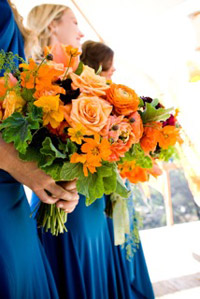The Four Seasons of Wedding Flowers
Grow Your Own Floral Contribution
Green weddings are not just trendy anymore — they make a statement. Couples who are concerned about the environment and their health no longer have to accept cookie-cutter weddings that use chemically altered or imported flowers. Growing your own flowers is a lovely way to personalize your wedding and save money, too.
If this is your first foray into flower growing, don’t be overzealous. Budding gardeners need not grow the flowers for the entire wedding. You might focus on your bride’s bouquets, your centerpieces, or simply edible flowers to decorate your cake.
Growing your own flowers is hard work. Consider asking family members and friends to help with your garden or ask what they might contribute from their gardens. A wonderful way to get them involved is to ask them to help with centerpieces. Have everyone pick flowers from their garden a few days before the wedding, then have a flower-arranging party. Flowers will hold up in vases or containers in fresh water for two or three days (please don’t use nonbiodegradable Oasis floral foam). Change the water the day of the wedding. Refrigerate centerpieces if the weather is hot.

Once you’ve decided what you want to grow, find out what will be in season and when to plant. Don’t try to grow sunflowers in January or freesias in July. For example, if you choose to include sweet peas (perhaps in honor of your mother’s favorite flower) in your spring wedding bouquet, read the seed packet and give yourself enough time to grow them for your event. If roses are your heart’s desire for your beloved’s boutonniere or for bud vases, plant bare root roses in January, fertilize with organic rose fertilizer, and water well for perfect chemical-free blooms. Plant dahlias in late spring for summer flowers, and plant bulbs in fall for spring flowers.
Roses are always a good choice, because if your buds do not blossom in time for your wedding, you can usually buy them at the Farmers Market year-round. And be sure to consult with a florist months before the wedding to ensure they are available if needed.
Timing is everything. Research growing and bloom seasons. Definitely have a backup plan, which may include consulting a florist. I grew organic roses, scented geranium, dahlias, and grasses for my daughter’s November wedding. I also bought organic flowers from Hill Top Farms (available at the Farmers Market) and purchased from a wholesaler. Although my roses didn’t survive the Tea Fire, thanks to my backup plan, the bouquets were still the most beautiful I have ever made.
Here’s a list of flowers that are relatively easy to grow, the best time to plant them, and suggestions on how to use them.
Spring: Buy Iceland poppies, larkspurs, and pansies by pony packs, and plant in the winter for spring. Plant sweet peas from seed or pony packs — they’ll bloom for many months in the spring. Ranunculus bulbs are planted in the fall, but you can buy four-inch pots for instant color. Plant freesia and iris bulbs in fall. Calla lilies bloom around Easter; plant the bulbs a year in advance or buy as plants. Pluck a sprig of orange blossoms to add as a special touch to the bride’s bouquet.
Summer: Lilies, dahlias, alstroemeria, and tuberoses are bulb types that should be planted after cool weather subsides, such as in the spring, for an early summer wedding. As a backup you can buy dahlias from a nursery throughout the summer months, but be sure to order them in advance (7 Day Nursery is a good source). Zinnia, cosmos, sunflowers, asters, and bachelor buttons are best grown from seed; plant in late spring for summer blooms. Check each packet for timing. Rudbeckia, pincushions, and herbs are best grown from pony packs, which are available early summer months. Plant lavender (the most fragrant variety is ‘Grosso’) in five-gallon pots any time. If you want gardenias, buy five-gallon pots, and they will bloom in the hotter months.
Fall: You can harvest beautiful foliage from maple, redbud, smoke tree, cotoneaster, grape vines, and magnolia in the fall. These should be planted a year in advance or harvested from a friend’s garden. Persimmons and pomegranates have great branches with attached fruits that are lovely in vase arrangements; plant a year in advance or harvest from a mature garden. Hydrangeas are available in spring in five-gallon containers. They will bloom all summer, but if you leave the flowers on the bush, you’ll have beautiful antique “mop heads” as a fall reward. Plant gladiola bulbs in summer for fall flowers. Dahlias can also be planted late summer for an autumn wedding.
Winter: Camellias are blooming at this time. They make beautiful floating centerpieces. Plant this slow-growing shrub a year in advance, or purchase them from a trusted gardener (I like Steve Lough at Four Seasons Garden Orchard). Hellebores planted in fall produce beautiful winter roses. Pansies, primroses, cyclamen, and forget-me-nots make excellent nosegays. Plant in fall or buy them flower-ready in pony packs or four-inch pots. Delphinium, snapdragons, and digitalis grow from pony packs; plant in fall. Amaryllis, freesia, muscari, narcissus, and anemones grown from bulbs should be planted in fall.
4•1•1
Trace Robinson is a landscape design contractor, floral and garden editor, and wedding and special event florist. For more information, call (805) 448-3807 or visit tracerobinson.com.



